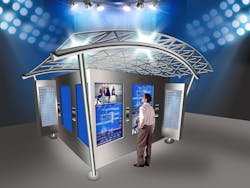How Digital Signage Technology is Revolutionizing Mass Transit
According to the American Public Transportation Association’s APTA 2014 Ridership Report, Americans took 10.8 billion trips using public transportation that year, which the report cited as the “highest transit ridership in 58 years.”
Because of the immense regular daily traffic, the need for digital signage at each station has become essential both to assist and facilitate the use of mass transit while keeping riders informed. Where appropriate, it may benefit transit operators if their digital signage communication network has the capacity to be utilized for promotions as well as third-party advertising, the latter of which can generate revenue by displaying advertisements on the digital real estate of the kiosk. Ideally, the installation of touchscreen indoor kiosks in key locations at each station can help travelers by providing them with departure and arrival information, delay notifications, and any point-of-service, such as automated ticket purchasing. Networked kiosks can also be remotely programmed to display promotions from any retailer in the station or for the station itself, such as frequent rider programs.
Bluetooth Integration Connects with Riders
By integrating Bluetooth beacon technology, kiosks can communicate with customers through a mobile app, which would allow travelers to use wayfinding around the station more efficiently. For those who may be unfamiliar with the technology, Bluetooth beacons are small sensors that transmit location information within short distances. For instance, a person using a kiosk chooses their preferred destination within the station. Once the destination such as an electronics store or restaurant is chosen, the mobile app can guide them through the station using Bluetooth beacons to transmit their location to show where they are headed. These beacons can be placed all over the station allowing customers to make their way around without getting lost.
Bluetooth beacons can also be utilized for advertising and promotions as well. For example, suppose a retailer would like to advertise their brand digitally to customers in transit who pass by the store or walk through different sections of the station by using their mobile devices. The retailer can purchase advertising space from the station. The station would then program the desired beacons through which the retailer would like to advertise. Thereafter, anytime a customer passes by a beacon, the retailer’s desired content such as advertisements or coupons will be sent to their mobile device. This not only eliminates the need for standard signs all over the station, but when utilizing Bluetooth beacons, a transit operator can provide a unique experience for customers and drive foot traffic to participating retailers.
Utilizing Exterior Kiosks
Digital signage can be extremely impactful at outdoor mass transit stops as well. By utilizing exterior kiosks, public transportation departments can assist travelers with a variety of different functions. A great tool that can be utilized is providing a map with live streaming location of vehicles such as buses and subway trains. This will be able to show travelers how close the vehicles are to the stop, as well as display any unexpected delays. It can also inform travelers of any additional information, such as schedule changes or pending construction. Outdoor kiosks can also have proximity sensors installed to trigger a message to the traveler when a person is a foot away from the sign. Having the proximity sensors allows patrons to interact with the kiosks and get the information they need, but not turn on every time someone is just passing in front of the kiosk.
Another opportunity to utilize exterior kiosks includes featuring points of interest in the surrounding area. By displaying any points of interest such as restaurants, salons and gyms, travelers can familiarize themselves with the area and give a boost to local businesses, and can be set up with the capacity to accommodate third-party advertising. Similar to gas station pumps, exterior kiosks can provide other content besides transportation schedules such as live video of the news, or a video loop with different content. Sports, talk shows and advertisements are just a few of the variety of options that could be shown at the stops.
Outdoor LED screens offer a more economical option for digital signage, but still provide an impact. They can exhibit the same messaging as the exterior kiosks, while providing vibrant and stunning visuals that can make advertisements more attractive to customers — and therefore, more attractive to advertisers.
These application solutions can maximize digital signage to its fullest potential. Using indoor and exterior kiosks provides an interactive experience for travelers; while Bluetooth beacons and outdoor LED screens offer a completely new opportunity to provide wayfinding and accommodate promotions. Digital signage can provide an enormous benefit to the mass transit industry and its patrons.
Alex Villa is part of marketing and media for Intermedia Touch Inc. He has been working for Intermedia Touch since May 2016 and has worked as a freelance writer since 2015.
Intermedia Touch is a member of the Digital Signage Federation, the only independent, not-for-profit trade organization serving the digital signage industry. The DSF supports and promotes the common business interests of worldwide digital signage, interactive technologies and digital out-of-home network industries. To learn more, go to www.digitalsignagefederation.org
